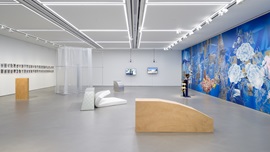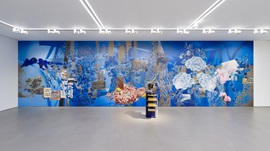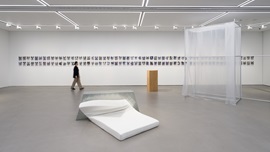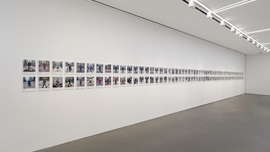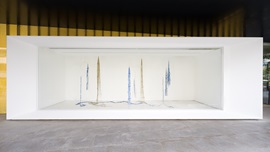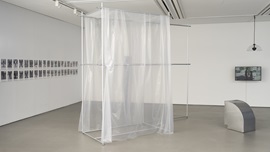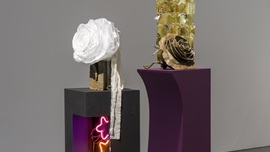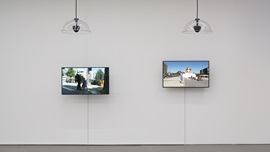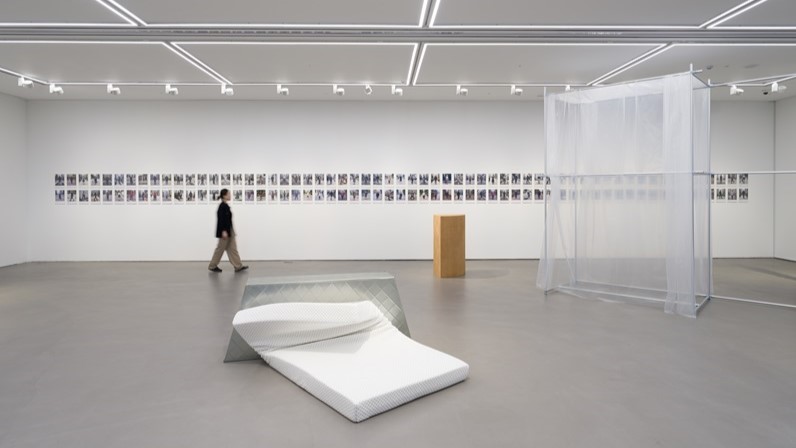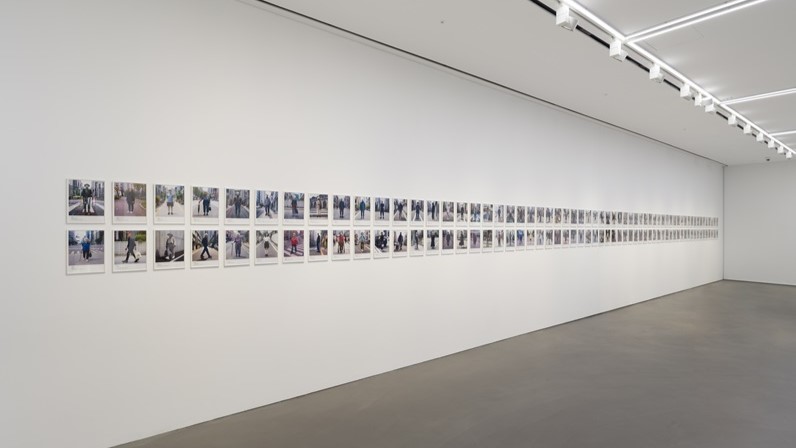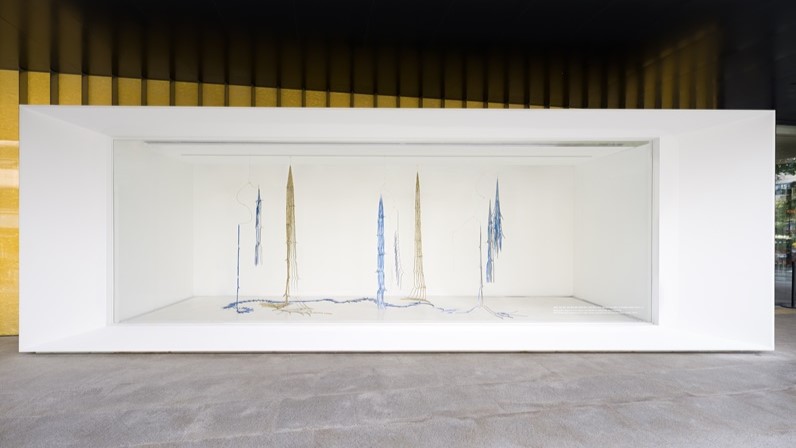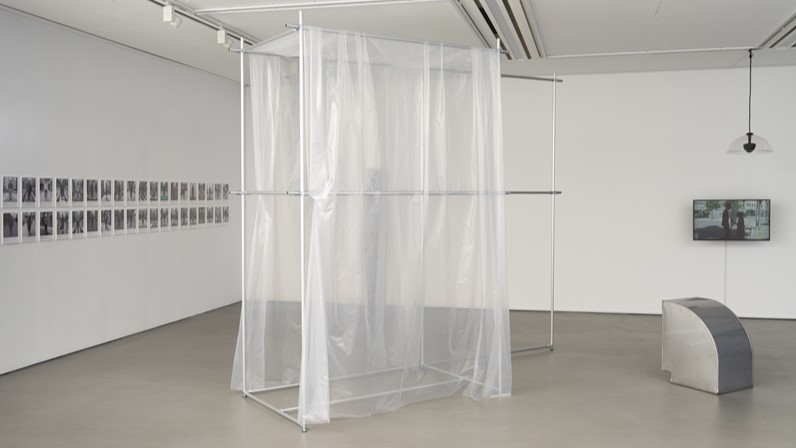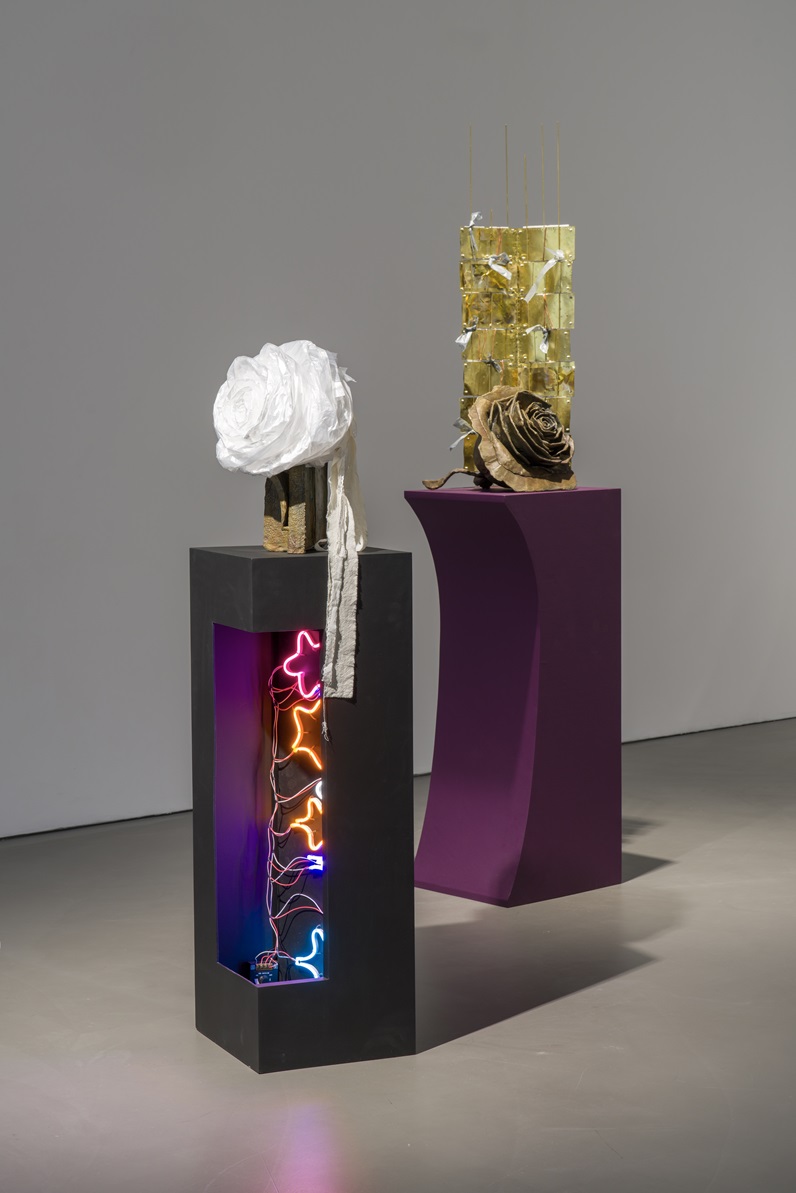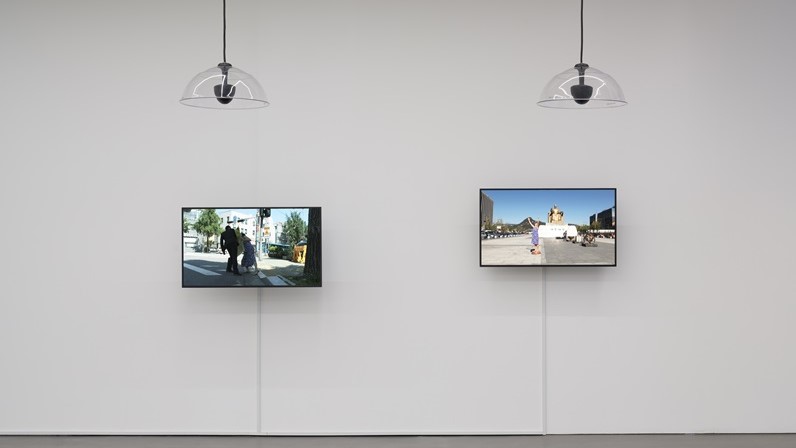
Installation View
Open Hours: Tuesday-Saturday 11:00~19:00 / Closed on Sunday, Monday
Special Open: Monday 6/9, 6/16, 6/23, 6/30 3pm–7:30pm
(On Mondays in June when DOOSAN Humanities Theater lectures are held, the gallery will be open for special hours from 3pm to 7:30pm.)
Venue: DOOSAN Gallery (15, Jongno 33-gil, Jongno-gu, Seoul, Korea)
Tel. 02-708-5050
DOOSAN Humanities Theater 2025 Exhibition Ringing Saga originates from the DOOSAN Art Center’s location in Jongno, in north-central Seoul. As the city’s tenth-largest district, Jongno—located in the heart of downtown Seoul—has long been filled with noise and bustling cityscapes.
Some of the things visitors might encounter on their way to the DOOSAN Art Center include the pharmacies right next to the subway station, which greet customers night and day with their bright lights. Across from the pharmacy road are Gwangjang Market—a must-visit location for those traveling to Seoul—and Bangsan Market behind it. Across a single bridge, you see fascinating, not easily blended contrasts between giddy tourists and itinerant workers. Traveling from one place to the next takes you through all the different reaches of Jongno, including Daehak-ro Road, Cheonggye Stream, Gwanghwamun, and Insa-dong. Layers of history are on display, with seemingly each new street representing a different era. As Seoul’s oldest city center, Jongno harbors marks of the city’s changing fortunes over the years. To observe it is to explore Seoul and to understand the larger structure of a city.
At the same time, Jongno also forms a special, one-on-one relationship with all the different people who travel through Seoul. Even for those who have no special connection to Jongno, the nature of the area as a place where different industries come together means that it provides countless people with a workplace, a leisure space, and a home. Its central geographical position means that it is somewhere everyone passes through or lingers in at some point. As a setting where all the different kinds of things and experiences a given setting encounters end up overlapping and differentiating in endless ways, Jongno is an environment of mediation, where relationships of universality and specificity operate in the most vivid sense. But is there anything to be found along Jongno’s main road that can be seen as unfamiliar?
Ringing Saga begins with this very question. The word “ringing” in the title conveys the idea of a vibrant, resonant sound, while “saga” suggests a heroic or epic narrative. This exhibition attempts to write a new tale of adventure with Jongno at its center. The five participating artists—Donghee Koo, Bokyung Kim, Jinseon Ahn, Eusung Lee, and HongLee, Hyunsook—serve as both discreet observers and explorers of the city. They create new landscapes by tying together the public moments and private memories. Alleys buzzing with mysterious energy, histories of oppression overshadowed by brightness, and speeds of urban redevelopment that would astonish ghosts—on each new step, an odd adventure unfolds.
Jinseon Ahn has slowly wandered through the Jongno area, observing images that instill feelings of anxiety. Her gaze captures architectural landscapes of repeated crumbling and building with the life cycles of an aging city. Into the gallery, she brings architectural materials that have been left visible, as if it were impossible to conceal their traces; discarded furniture deemed to have outlived its usefulness; and curtains that await the new. Her new works here take their names from objects found on the street: Bookshelf (2025), Drawer Cabinet (2025), Mattress (2025), and so forth. These have been reconfigured in ways that differ from their original form and use, creating a landscape of urban reconstruction in their temporary gallery dwelling. Viewers experience vibrations that alternate between déja vu and jamais vu.
Eusung Lee presents new works that draw out old dormant memories from her own unconscious and hybridize them with the symbols of Jongno. Reminiscing over past locations that shaped a particular era for her—movie theaters, side streets at night, and so forth—she creates real-world simulations of the fictional settings she discovered through them. At the heart of this visual allegory lies the image of a “rose.” Throughout most of human history, roses have played the part of complex cultural symbols, and they also share associations with the universal and specific aspects of Jongno. Eusung Lee has experimented with combining disparate symbols, objects and materialities to discover unexpected energies and ways of being that emerge from them. In Bagdad (2025), A mole's night in the jar (2025), and Exchange (2025), roses and architectural models are combined in strange ways, realized in materials that each bear their own textures, patterns, and weights: bronze, plastic bags, brass plates, tarnished urethane foam, fabric scraps, and more. Condensed in these sculptures are the feelings of desolation sensed while wandering the side streets of Jongno; dull, not easily detected flows of time; and energies that move in strange directions.
Bokyung Kim applies a methodology of “unraveling” and “weaving” to porously connect large and small histories, past and present, and the part and the whole. An entire wall is taken up by her new work Colony of Scrolls—Sprawling from Beneath the Ground (2025), which began from an exploration of buncheong ware fragments unearthed in the early 2000s in the old Pimat-gil area of Jongno 1-ga. Focusing on the blue and white pottery, it weaves together a vast history of civilization as it relates to materials, patterns, and trade routes. Kim’s digital collages unite a history of cobalt extraction and the search for this pigment used in blue and white pottery; the unfolding history of arabesque patterns, which express wishes for longevity; and the old Jongno cityscape that serves as a commercial center. This non-linear chronology traces the omnidirectional pathways of movement within. The same story also appears in mobile form with Trajectory of the Pattern (2025) in the Gallery, which visualizes how elements without any immediately visible intersection can come together to form vinelike linkages.
The video works Gwanghwamun Still Life (2011) and Picketing (2016) by HongLee, Hyunsook restructure the relationships that surround places. Their backdrops are the ordinary yet exceedingly political settings of Gwanghawmun and Hyoja-dong Junction, with the artist appearing as an odd figure in a blue floral-print dress. Standing on the square, she becomes a living still-life and an obstacle to others’ passage, as she attempts to introduce out-of-the-day fractures into familiar environments. The ones she is seeking to represent through her actions are us and the undefinable others “who surround us”: victims of national tragedies, ordinary people with a minimal voice, women, members of minorities, and so forth. Over a period of time, we observe two squares that take on a new meaning each year, rediscovering the past and our memories as we consider what has changed and what remains the same.
Donghee Koo examines the contradictions that arise in our everyday lives, applying an approach of magnification and transformation that reveals the unusual underside of the world. Tabula Rasa (2023–2025), with its phantasmal figures wandering through the city, poses questions about the system used to manage urban records. Since 2023, Koo has been assembling a collection of missing person notifications from various parts of Seoul and analyzing the patterns within them. The information given for missing persons is usually quite concrete in nature, with details about their gender, age, clothing, and last known location. Nevertheless, they make it difficult for us to imagine them as they actually are. Donghee Koo enters information into an AI image generator to give the missing people bodies. Yet the resulting images reflect results based on big data, and they repeatedly feature stereotyped images of Koreans showing the clothing, styles, and appearances popular during a particular era. The image representations conjured by the patterned information values reveal the anonymity and gaps within the urban information system—one that refers to specific people, yet does not denote anyone precisely.
In many respects, Ringing Saga starts from images in reality, but it also keeps breaking away from real-world temporality to acquire a specific sense of space and time. Here, it falls on the viewer to leave the gallery carrying the strange images they have witnessed. Where will their next stop be? Some might venture back out into the bustle of Jongno and enjoy a cup of tea nearby; others may reflect anew on familiar things or venture on long walks in search of new things. Some might simply go home. All these are different adventures that occur in Jongno and in the city. The protagonist in the adventure of everyday life might be someone who diligently heads to work in Jongno upon waking, someone who stops in the area to see an exhibition and buy materials, or a traveler who wanders the side streets in search of new experiences.
Donghee Koo (b. 1974) is a Seoul-based artist who works in various media, including sculpture, installation, video, and photography. She has held solo exhibitions at the Audio Visual Pavilion Lab (2023, Seoul, KR), the Kunsthal Aarhus (2022, Aarhus, DM), Art Sonje Center (2019, Seoul, KR), Perigee Gallery (2018, Seoul, KR), and the DOOSAN Art Center DOOSAN Gallery (2012, Seoul, KR). She was awarded the inaugural DOOSAN Yonkang Arts Awards (2010) and the 13th Hermès Foundation Missulsang (2012), and she was a Korea Artist Prize finalist in 2014.
Bokyung Kim (b. 1988) applies her image research in work that uses media such as collage, risograph printing, knitting, and weaving. She has held solo exhibitions at Jungganjijeom II (2024, Seoul, KR), Buyeon (2023, Incheon, KR), and Project Space Daseossure (2022, Seoul, KR). She has also presented three exhibitions through her activities as a member of the collective 25hr sailing and taken part in other exhibitions at YPC SPACE (2022, Seoul, KR), Space Imsi (2021, Incheon, KR), and N/A (2021, Seoul, KR).
Jinseon Ahn (b. 1996) is a Seoul-based artist who creates sculptures, installations, and spaces. She has held a solo exhibition at Mueumsanbang (2023, Seoul, KR) and presented her work at the Nam-Seoul Museum of Art (2024, Seoul, KR), Chamber 1965 (2023, Seoul, KR), the Yesong Museum of Art (2023, Seoul, KR), Rainbow Cube (2021, Seoul, KR).
Eusung Lee (b. 1989) is a sculptor who lives and works in Seoul. She has held solo exhibitions at TSA NY (2023, DOOSAN International Exhibition Program, New York, US) and Artspace Boan 3 (2023, Seoul, KR). She has also participated in group exhibitions at the Seoul Museum of Art, Seosomun Main Branch (2025, Seoul, KR), the 7th Changwon Sculpture Biennale (2024, Changwon, KR), and the Ilmin Museum of Art (2024, Seoul, KR). She was selected as a Seoul Museum of Art Emerging Artist in 2023 and entered Seoul Museum of Art Nanji Residency in 2022.
HongLee, Hyunsook (b. 1958) is an artist whose diverse body of work spans media including performance, video, and installation. She has held solo exhibitions at the Coreana Museum of Art (2022, Seoul, KR), Bucheon Art Bunker B39 (2021, Bucheon, KR), and ARKO Art Center (2021, Seoul, KR). She has also participated in group exhibitions at the Buk-Seoul Museum of Art (2024, Seoul, KR) and the National Museum of Modern and Contemporary Art (2024, Seoul, KR) and numerous biennial events, including the 2024 Busan Biennale and 14th Gwangju Biennale.


